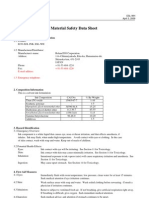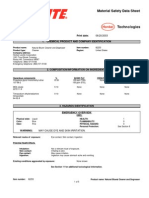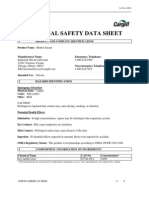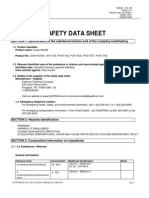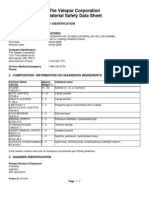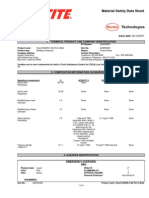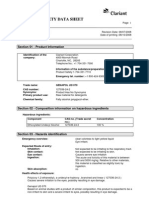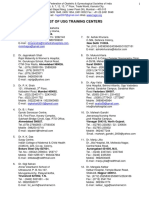Msds Brake Fluids Federal-Mogul
Msds Brake Fluids Federal-Mogul
Uploaded by
Elías VillegasCopyright:
Available Formats
Msds Brake Fluids Federal-Mogul
Msds Brake Fluids Federal-Mogul
Uploaded by
Elías VillegasOriginal Description:
Original Title
Copyright
Available Formats
Share this document
Did you find this document useful?
Is this content inappropriate?
Copyright:
Available Formats
Msds Brake Fluids Federal-Mogul
Msds Brake Fluids Federal-Mogul
Uploaded by
Elías VillegasCopyright:
Available Formats
Dot 3 Premium Brake Fluid
25-Oct-2011
MATERIAL SAFETY DATA SHEET
1
PRODUCT AND COMPANY IDENTIFICATION
Product Name:
Product No.:
Dot 3 Premium Brake Fluid
H-130 (21-b)
Emergency Telephone:
24hr EP (INFOTRAC): 1-800-535-5053
International: (001) 352-323-3500
Manufacturer Name:
Federal-Mogul World Headquarters
26555 Northwestern Highway
Southfield, Michigan 48033
Non-emergency Telephone:
1-248-354-9844
Intended Use:
Brake Fluid
Contact Person:
MSDS Request (voicemail) 1-248-354-9844
HAZARDS IDENTIFICATION
Emergency Overview
Physical State:
Liquid
Color:
Light amber
Odor:
Mild
WARNING!
Causes severe skin and eye irritation. Harmful if swallowed. May be harmful if absorbed through skin.
May cause respiratory tract irritation. May cause damage to the kidneys. May cause central nervous
system effects.
Possible reproductive hazard - contains material that may cause adverse reproductive
effects.
Potential Health Effects
Inhalation:
Eye Contact:
May cause respiratory tract irritation.
Causes severe eye irritation.
May cause central nervous system effects.
Causes redness and pain.
Skin Contact: Causes severe skin irritation. May be harmful if absorbed through skin. Defats the
skin.
A few cases of sensitization have been reported. The product contains components which may
penetrate skin.
Ingestion: Harmful if swallowed. May cause damage to the kidneys. May cause central nervous
system effects. May damage the unborn child if large amounts are swallowed.
Chronic Health Effects: May cause central nervous system effects.
May cause damage to the liver
and kidneys. Possible reproductive hazard - contains material that may cause adverse reproductive
effects.
NORTH AMERICAN MSDS
1/
Dot 3 Premium Brake Fluid
25-Oct-2011
Target Organ(s): | Eye | Skin |
| Liver | Reproductive system |
OSHA Regulatory Status:
Respiratory system |
Central nervous system |
Kidney
This product is hazardous according to OSHA 29CFR 1910.1200.
Environment: The product components are not classified as environmentally hazardous. However, this
does not exclude the possibility that large or frequent spills can have a harmful or damaging effect on the
environment.
3
COMPOSITION / INFORMATION ON INGREDIENTS
General Information:
The product is a mixture.
Chemical Name
Triethylene glycol monobutyl ether
Diethylene glycol
Polyethylene glycol hexylether
2-(2-butoxyethoxy)ethanol
Triethylene glycol methyl ether
Polyethylene glycol
Diethylene glycol monoethyl ether
Triethylene glycol
Triethylene glycol ethyl ether
2-(2-propoxyethoxy)ethanol
2-(2-methoxyethoxy)ethanol
Ethylene glycol
* All concentrations are in percent by weight unless ingredient is a gas.
This chemical is hazardous according to OSHA/WHMIS criteria.
4
Inhalation:
CAS-No.
143-22-6
111-46-6
112-59-4
112-34-5
112-35-6
25322-68-3
111-90-0
112-27-6
112-50-5
6881-94-3
111-77-3
107-21-1
Concentration*
25 - 29%
16 - 20%
11 - 15%
10 - 14%
7 - 11%
4 - 8%
3 - 6%
1 - 5%
2 - 6%
2 - 6%
<= 4%
<= 4%
Gas concentrations are in percent by volume.
FIRST AID MEASURES
Move into fresh air and keep at rest.
Eye Contact: Flush thoroughly with water for at least 15 minutes. Get immediate medical assistance. If
medical assistance is not immediately available, flush an additional 15 minutes. Get medical attention
immediately. Continue to rinse.
Skin Contact: Remove contaminated clothes and rinse skin thoroughly with water for at least 15
minutes. Get medical attention promptly if symptoms persist or occur after washing.
Ingestion: Rinse mouth thoroughly with water and give large amounts of milk or water, if person is
conscious. Only induce vomiting at the instruction of medical personnel. Get medical attention
immediately.
Note to Physician:
5
Treat symptomatically.
FIRE-FIGHTING MEASURES
Extinguishing Media:
Extinguish with foam, carbon dioxide, dry powder or water fog.
NORTH AMERICAN MSDS
2/
Dot 3 Premium Brake Fluid
25-Oct-2011
Unsuitable Extinguishing Media:
None.
Special Fire Fighting Procedures:
other involved materials.
Use standard firefighting procedures and consider the hazards of
Unusual Fire & Explosion Hazards:
Hazardous Combustion Products:
During fire, gases hazardous to health may be formed.
Carbon Dioxide, Carbon Monoxide
Protective Measures:
Selection of respiratory protection for fire fighting: follow the general fire
precautions indicated in the workplace. Self-contained breathing apparatus and full protective clothing
must be worn in case of fire.
Flammability Class:
occur.
6
NFPA Rating Fire = 1. Materials that must be preheated before ignition can
ACCIDENTAL RELEASE MEASURES
Personal Precautions: Avoid inhalation of vapors and contact with skin and eyes. Wear suitable
protective clothing and gloves. See Section 8 of the MSDS for Personal Protective Equipment.
Spill Cleanup Methods:
Absorb spillage with suitable absorbent material. Collect in containers and
seal securely.
Containers with collected spillage must be properly labeled with correct contents and
hazard symbol.
For waste disposal, see section 13 of the MSDS.
Environmental Precautions:
Notification Procedures:
7
Avoid discharge into drains, water courses or onto the ground.
Inform authorities if large amounts are involved.
HANDLING AND STORAGE
Handling: Pregnant women should not work with the product, if there is the least risk of exposure.
Local exhaust is recommended. Avoid inhalation of vapors and contact with skin and eyes. Wear
necessary protective equipment.
Observe good industrial hygiene practices.
Storage: Store in a cool and well-ventilated place.
incompatible materials.
8
Keep containers tightly closed.
Store away from
EXPOSURE CONTROLS / PERSONAL PROTECTION
Exposure Limits:
Chemical Name
Diethylene glycol
Diethylene glycol monoethyl
ether
Ethylene glycol (Aerosol.)
Polyethylene glycol
(Particulate.)
Triethylene glycol (Particulate.)
Source
US. AIHA WEEL
US. AIHA WEEL
Type
TWA
TWA
Exposure Limits
10 mg/m
140 mg/m 25 ppm
US. ACGIH TLV
US. AIHA WEEL
Ceiling
TWA
100 mg/m
10 mg/m
US. AIHA WEEL
TWA
10 mg/m
Notes
Consult Canadian Provincial Regulations and/or Mexican Regulations on exposure limits, if applicable.
NORTH AMERICAN MSDS
3/
Dot 3 Premium Brake Fluid
25-Oct-2011
Engineering Controls: Provide adequate ventilation. Observe Occupational Exposure Limits and
minimize the risk of inhalation of vapors. Provide easy access to water supply and eye wash facilities.
Respiratory Protection: If engineering controls do not maintain airborne concentrations below
recommended exposure limits (where applicable) or to an acceptable level (in countries where exposure
limits have not been established), an approved respirator must be worn. In the United States of America,
if respirators are used, a program should be instituted to assure compliance with OSHA Standard 29CFR
1910.134. Use a NIOSH/MSHA approved air purifying respirator as needed to control exposure.
Consult with respirator manufacturer to determine respirator selection, use, and limitations. Use positive
pressure air supplied respirator for uncontrolled releases or when air purifying respirator limitations may
be exceeded. Follow respirator protection program requirements (OSHA 1910.134 and ANSI Z88.2) for
all respirator use.
Eye Protection:
Wear approved safety goggles.
Hand Protection:
Wear protective gloves. Be aware that the liquid may penetrate the gloves.
Frequent change is advisable. Suitable gloves can be recommended by the glove supplier.
Skin Protection:
Wear appropriate clothing to prevent any possibility of skin contact.
Hygiene Measures:
Always observe good personal hygiene measures, such as washing after handling
the material and before eating, drinking, and/or smoking. Routinely wash work clothing and protective
equipment to remove contaminants. Observe any medical surveillance requirements.
Environmental Exposure Controls:
9
Environmental manager must be informed of all major spillages.
PHYSICAL AND CHEMICAL PROPERTIES
Color:
Light amber
Odor:
Mild
Odor Threshold:
No data available.
Physical State:
Liquid
pH:
9.5 - 10.5
Melting Point:
No data available.
Freezing Point:
No data available.
Boiling Point:
>205C (401F)
Flash Point:
No data available.
Evaporation Rate:
No data available.
Flammability Limit - Upper (%):
No data available.
Flammability Limit - Lower (%):
No data available.
Vapor Pressure:
No data available.
Vapor Density (Air=1):
No data available.
Specific Gravity: 1.028 - 1.036 (20C)
Solubility in Water:
Soluble
Solubility (Other):
No data available.
Partition Coefficient (n-Octanol/water):
No data available.
Autoignition Temperature:
No data available.
Decomposition Temperature: No data available.
Volatile Organic Compounds (VOC):
No data available.
Viscosity:
No data available.
NORTH AMERICAN MSDS
4/
Dot 3 Premium Brake Fluid
10
25-Oct-2011
STABILITY AND REACTIVITY
Stability:
This product is stable under expected conditions of use.
Conditions to Avoid:
Avoid exposure to high temperatures or direct sunlight.
Incompatible Materials:
Strong oxidizing agents.
Strong bases.
Hazardous Decomposition Products:
At Elevated Temperatures:
Carbon Dioxide, Carbon Monoxide
Possibility of Hazardous Reactions:
11
Will not occur.
TOXICOLOGICAL INFORMATION
Specified Substance(s)
Acute Toxicity:
Chemical Name
2-(2-butoxyethoxy)ethanol
2-(2-butoxyethoxy)ethanol
Diethylene glycol monoethyl ether
Diethylene glycol monoethyl ether
2-(2-methoxyethoxy)ethanol
2-(2-methoxyethoxy)ethanol
Polyethylene glycol hexylether
Polyethylene glycol hexylether
Diethylene glycol
Diethylene glycol
Ethylene glycol
Ethylene glycol
Triethylene glycol monobutyl ether
Triethylene glycol monobutyl ether
Triethylene glycol
Triethylene glycol
Triethylene glycol ethyl ether
Triethylene glycol ethyl ether
Triethylene glycol methyl ether
Triethylene glycol methyl ether
Test Results
Dermal LD50 (Rabbit): 2700 mg/kg
Oral LD50 (Rat): 5600 mg/kg
Inhalation LC50 (4 hour(s), Rat): > 5240 mg/m
Oral LD50 (Rat): 7500 mg/kg
Dermal LD50 (Rabbit): 2.5 ml/kg
Oral LD50 (Rat): 4 ml/kg
Dermal LD50 (Rabbit): 1425 mg/kg
Oral LD50 (Rat): 2400 mg/kg
Dermal LD50 (Rabbit): 11890 mg/kg
Oral LD50 (Rat): 12565 mg/kg
Dermal LD50 (Rabbit): 9.3 mg/kg
Oral LD50 (Rat): 4700 mg/kg
Dermal LD50 (Rabbit): 3.57 ml/kg
Oral LD50 (Rat): 5300 mg/kg
Dermal LD50 (Rabbit): > 20 ml/kg
Oral LD50 (Rat): 17000 mg/kg
Dermal LD50 (Rabbit): 8000 mg/kg
Oral LD50 (Rat): 7750 mg/kg
Dermal LD50 (Rabbit): 7100 mg/kg
Oral LD50 (Rat): 11300 mg/kg
Chronic Toxicity: Ethylene glycol (EG):
Repeated high oral exposure has caused kidney damage,
neurological effects, degeneration of the liver and changes in blood chemistry and circulating blood cells
in laboratory animals. Repeated overexposure has the potential to cause similar toxic effects in humans.
EG causes developmental and reproductive effects at high dose levels in laboratory animals. The
relevance of these findings to humans is uncertain. However, as a precaution, avoid exposure during
pregnancy.
Listed Carcinogens:
Chemical Name
Ethylene glycol
IARC:
1 = Carcinogenic to Humans;
NORTH AMERICAN MSDS
IARC
Not Listed
NTP
Not Listed
OSHA
Not Listed
ACGIH
A4
2A = Probably Carcinogenic to Humans; 2B = Possibly Carcinogenic to Humans;
5/
Dot 3 Premium Brake Fluid
25-Oct-2011
= Not classifiable as to carcinogenicity to humans; 4 = Probably not carcinogenic to humans; Not listed = Not evaluated by
IARC.
ACGIH: A1 = Confirmed Human Carcinogen; A2 = Suspected Human Carcinogen; A3 = Confirmed Animal Carcinogen;
A4 = Not classifiable as a human carcinogen; A5 = Not suspected to be a human carcinogen; Not listed = Not evaluated by
ACGIH.
Product Information
Acute Toxicity:
Test Results: No test data available for the product.
Other Acute:
Causes severe skin and eye irritation. Harmful if swallowed. May cause respiratory
tract irritation. May be harmful if absorbed through skin. May cause central nervous system effects.
May cause damage to the kidneys.
Chronic Toxicity: May cause central nervous system effects.
May cause damage to the liver and
kidneys. Possible reproductive hazard - contains material that may cause adverse reproductive effects.
A few cases of sensitization have been reported.
12
ECOLOGICAL INFORMATION
Ecotoxicity:
The product components are not classified as environmentally hazardous. However, this
does not exclude the possibility that large or frequent spills can have a harmful or damaging effect on the
environment.
Specified Substance(s)
Chemical Name
2-(2-methoxyethoxy)ethanol
Diethylene glycol
Diethylene glycol
Diethylene glycol
Diethylene glycol
Ethylene glycol
Ethylene glycol
Triethylene glycol
Triethylene glycol
Mobility:
Test
LC50 (96 hour(s), Bluegill Sunfish): 7500 ppm
EC50 (Daphnia): 49000 mg/l
LC50 (Rainbow trout): >1000 mg/l
LC50 (Fathead Minnow): 78000 mg/l
LC50 (Goldfish): >5000 mg/l
LC50 (96 hour(s), Rainbow trout): 18500 mg/l
LC50 (24 hour(s), Goldfish): 5000 mg/l
LC50 (96 hour(s), Bluegill Sunfish): > 10000 ppm
LC50 (96 hour(s), Fathead Minnow): 70.2 g/l
The product is water soluble and may spread in water systems.
Persistence and Degradability:
Bioaccumulation Potential:
Other Adverse Effects:
13
No data available.
No data available.
No data available.
DISPOSAL CONSIDERATIONS
General Information:
Dispose in accordance with applicable federal, state, and local regulations.
Disposal Methods:
Disposal recommendations are based on material as supplied. Disposal must be
in accordance with current applicable laws and regulations, and material characteristics at time of
disposal.
NORTH AMERICAN MSDS
6/
Dot 3 Premium Brake Fluid
RCRA Information:
Container:
is emptied.
TRANSPORT INFORMATION
DOT
Not regulated.
TDG
Not regulated.
IMDG
Not regulated.
Since emptied containers retain product residue, follow label warnings even after container
14
IATA
25-Oct-2011
Not regulated.
Not regulated.
15
REGULATORY INFORMATION
Canadian Controlled Products Regulations: This product has been classified according to the hazard
criteria of the Canadian Controlled Products Regulations, Section 33, and the MSDS contains all required
information.
WHMIS Classification:
D2A, D2B
Mexican Dangerous Statement:
This product is dangerous according to Mexican regulations.
US Regulations
CERCLA Hazardous Substance List (40 CFR 302.4):
Chemical Name
2-(2-butoxyethoxy)ethanol
Diethylene glycol monoethyl ether
Ethylene glycol
Polyethylene glycol hexylether
2-(2-methoxyethoxy)ethanol
2-(2-propoxyethoxy)ethanol
Triethylene glycol monobutyl ether
Triethylene glycol ethyl ether
Triethylene glycol methyl ether
RQ
5000 lbs
-
- : No reportable quantity.
SARA Title III
Section 302 Extremely Hazardous Substances (40 CFR 355, Appendix A):
Not regulated.
Section 311/312 (40 CFR 370):
X Acute (Immediate)
X Chronic (Delayed)
Fire
Section 313 Toxic Release Inventory (40 CFR 372):
Chemical Name
CAS-No.
NORTH AMERICAN MSDS
Reactive
Reporting threshold
for other users
Pressure Generating
Reporting threshold
for manufacturing
and processing
7/
Dot 3 Premium Brake Fluid
25-Oct-2011
Diethylene glycol monoethyl ether
2-(2-methoxyethoxy)ethanol
2-(2-propoxyethoxy)ethanol
2-(2-butoxyethoxy)ethanol
Polyethylene glycol hexylether
Triethylene glycol monobutyl ether
Ethylene glycol
Triethylene glycol ethyl ether
Triethylene glycol methyl ether
111-90-0
111-77-3
6881-94-3
112-34-5
112-59-4
143-22-6
107-21-1
112-50-5
112-35-6
10000 lbs
10000 lbs
10000 lbs
10000 lbs
10000 lbs
10000 lbs
10000 lbs
10000 lbs
10000 lbs
25000 lbs
25000 lbs
25000 lbs
25000 lbs
25000 lbs
25000 lbs
25000 lbs
25000 lbs
25000 lbs
For reporting purposes: the De Minimis Concentration for a toxic chemical in a mixture is 0.1% for carcinogens as defined in 29
CFR 1910.1200(d)(4) or 1% for others.
Clean Air Act (CAA) Section 112(r) Accidental Release Prevention (40 CFR 68.130):
Not regulated.
Clean Water Act Section 311 Hazardous Substances (40 CFR 117.3):
Drug Enforcement Act:
Not regulated.
Not regulated.
TSCA
TSCA Section 4(a) Final Test Rules & Testing Consent Orders:
Not regulated.
TSCA Section 5(a)(2) Final Significant New Use Rules (SNURs) (40CFR 721, Subpt. E):
regulated.
TSCA Section 5(e) PMN-Substance Consent Orders:
Not
Not regulated.
TSCA Section 12(b) Export Notification (40 CFR 707, Subpt. D):
Not regulated.
State Regulations
California Safe Drinking Water and Toxic Enforcement Act of 1986 (Proposition 65):
regulated.
Massachusetts Right-To-Know List:
Not
2-(2-methoxyethoxy)ethanol; Ethylene glycol
Michigan Critical Materials List (Michigan Natural Resources and Environmental Protection Act
(Act. 451 of 1994)):
Not regulated.
Minnesota Hazardous Substances List:
Diethylene glycol; Diethylene glycol monoethyl ether;
Ethylene glycol; Polyethylene glycol; Triethylene glycol
New Jersey Right-To-Know List:
2-(2-butoxyethoxy)ethanol; 2-(2-methoxyethoxy)ethanol;
2-(2-propoxyethoxy)ethanol; Diethylene glycol monoethyl ether; Ethylene glycol; Polyethylene glycol
hexylether; Triethylene glycol ethyl ether; Triethylene glycol methyl ether; Triethylene glycol monobutyl
ether
Pennsylvania Right-To-Know List:
2-(2-butoxyethoxy)ethanol; 2-(2-methoxyethoxy)ethanol;
2-(2-propoxyethoxy)ethanol; Diethylene glycol; Diethylene glycol monoethyl ether; Ethylene glycol;
Polyethylene glycol hexylether; Triethylene glycol; Triethylene glycol ethyl ether; Triethylene glycol
NORTH AMERICAN MSDS
8/
Dot 3 Premium Brake Fluid
25-Oct-2011
methyl ether; Triethylene glycol monobutyl ether
Rhode Island Right-To-Know List:
16
Diethylene glycol; Ethylene glycol; Triethylene glycol
OTHER INFORMATION
HAZARD RATINGS
NFPA
Health Hazard
2
Fire Hazard
1
Instability
0
Special Hazard
0
Hazard rating: 0 - Minimal; 1 - Slight; 2 - Moderate; 3 - Serious; 4 - Severe
NFPA Label colored diamond code: Blue - Health; Red - Flammability; Yellow - Instability; White - Special Hazards
HMIS
Health Hazard
2*
Flammability
1
Physical Hazard
0
Personal Protection
X
Hazard rating: 0 - Minimal; 1 - Slight; 2 - Moderate; 3 - Serious; 4 - Severe *- Chronic Health Effect
Personal Protection codes: X - Specialized Handling
HMIS Label colored bar code: Blue - Health; Red - Flammability; Orange - Physical Hazards; White - Special
This MSDS contains revisions in the following section(s):
13, 15, 16.
2, 4,
5,
6, 7,
8,
9, 10,
11,
Issued by: Federal-Mogul Corporation
Issue Date: 25-Oct-2011
Supercedes Date:
30-Sep-2008
SDS No.:
3E-(21-b)
Disclaimer: The information provided on this data sheet was abstracted from supplier material safety
data sheets and standard references in occupational health and toxicology. Federal-Mogul makes no
representation or warranty with respect to the information obtained from such references. The
information is however, as of the date provided, true and accurate to the best of Federal-Mogul's
knowledge, and should be used to make an independent determination of the methods to safeguard
workers and the environment.
NORTH AMERICAN MSDS
9/
You might also like
- Critical Care Medication Infusion ChartDocument2 pagesCritical Care Medication Infusion ChartEgi Munandar100% (2)
- The Secrets To Gaining Muscle Mass Fast by Anthony Ellis PDFDocument125 pagesThe Secrets To Gaining Muscle Mass Fast by Anthony Ellis PDFVishal DokaniaNo ratings yet
- Pre Grad Learning PlanDocument3 pagesPre Grad Learning Planapi-315231385No ratings yet
- The Health & Safety Guide for Film, TV & Theater, Second EditionFrom EverandThe Health & Safety Guide for Film, TV & Theater, Second EditionRating: 4 out of 5 stars4/5 (1)
- Turco 5351 MsdsDocument5 pagesTurco 5351 MsdsElías VillegasNo ratings yet
- Physiological Changes During PregnancyDocument56 pagesPhysiological Changes During PregnancyReshmi100% (5)
- The Complete Book of Family Homeopathic Medicine (PDFDrive) PDFDocument184 pagesThe Complete Book of Family Homeopathic Medicine (PDFDrive) PDFjulia90% (10)
- MSDS Esl-WhDocument4 pagesMSDS Esl-WhankitleedsNo ratings yet
- Es15sds (Epa) PDFDocument8 pagesEs15sds (Epa) PDFJeremy TurnageNo ratings yet
- Msds MFG 4141 - MoldReleaseConctrtDocument3 pagesMsds MFG 4141 - MoldReleaseConctrtJean ValjeanNo ratings yet
- Material Safety Data Sheet - Docx EtilenglikolDocument7 pagesMaterial Safety Data Sheet - Docx EtilenglikolHasna KhoirunnisaNo ratings yet
- Fiche de Sécurité TEF GELDocument3 pagesFiche de Sécurité TEF GELNur IslamiaNo ratings yet
- Prime SP Developer Working SolutionDocument7 pagesPrime SP Developer Working SolutionelsokukabaNo ratings yet
- Alfamar MsdsDocument6 pagesAlfamar Msdsvangeliskyriakos8998No ratings yet
- Material Safety Data Sheet: Revision Date: 06/20/2003 Print DateDocument5 pagesMaterial Safety Data Sheet: Revision Date: 06/20/2003 Print DatejnilanNo ratings yet
- Uranium Nitrate MsdsDocument8 pagesUranium Nitrate MsdsAnonymous mZEUquNo ratings yet
- Methyl Soyate MSDSDocument6 pagesMethyl Soyate MSDSEric MakkasNo ratings yet
- CFR 3Document6 pagesCFR 3advantage025No ratings yet
- Aerochem Veiligheid Mono Ethylene GlycolDocument6 pagesAerochem Veiligheid Mono Ethylene Glycolsales putrariNo ratings yet
- Composition/Information On Ingredients: Material Safety Data SheetDocument6 pagesComposition/Information On Ingredients: Material Safety Data SheetrrebollarNo ratings yet
- Loc Tite 545Document5 pagesLoc Tite 545Mark Evan SalutinNo ratings yet
- JD Sunlight Liq DishDocument4 pagesJD Sunlight Liq DishmansuraquelNo ratings yet
- Safety Data Sheet Sulfuric Acid, 3M: Section 1 Product DescriptionDocument4 pagesSafety Data Sheet Sulfuric Acid, 3M: Section 1 Product DescriptionphyphoNo ratings yet
- Santovac 5 SDS PDFDocument5 pagesSantovac 5 SDS PDFmanish_keswani01No ratings yet
- EastmanDocument14 pagesEastmanapi-286047984No ratings yet
- Section 1: Product & Company IdentificationDocument7 pagesSection 1: Product & Company Identificationodonk23No ratings yet
- MSDS-HbA1c Calibrator-2019-非危-1.4Document7 pagesMSDS-HbA1c Calibrator-2019-非危-1.4laboratorium rsst klatenNo ratings yet
- Msds For TretinionDocument10 pagesMsds For TretinionYen Ling NgNo ratings yet
- Gasstop HTDocument6 pagesGasstop HTadvantage025No ratings yet
- MSDS AAY0953.PDF - Topcoat YellowDocument7 pagesMSDS AAY0953.PDF - Topcoat YellowdevdossbNo ratings yet
- Oil Eater Degreaser Cleaner Kafko InternationalDocument3 pagesOil Eater Degreaser Cleaner Kafko InternationalstevgonNo ratings yet
- Hoja de Seguridad 242Document6 pagesHoja de Seguridad 242Gabo TellezNo ratings yet
- Luteolin (Cas 491-70-3) MSDSDocument6 pagesLuteolin (Cas 491-70-3) MSDSoffice8187No ratings yet
- Material Safety Data Sheet: (Acute and Chronic)Document4 pagesMaterial Safety Data Sheet: (Acute and Chronic)Muhammad Andhika AlfaridziNo ratings yet
- MSDS, Hysol Ea 9309.3 NaDocument5 pagesMSDS, Hysol Ea 9309.3 NaAlexandre PortelaNo ratings yet
- MSDS FDC Yellow No%6 Aluminum Lake 15-18Document6 pagesMSDS FDC Yellow No%6 Aluminum Lake 15-18Vanti_805No ratings yet
- Alkohol 70% PDFDocument7 pagesAlkohol 70% PDFErik JuniarthaNo ratings yet
- Naval JellyDocument4 pagesNaval JellyjohnsopranaNo ratings yet
- Molykote L 8030 Lubricant US SDS 000000842729Document9 pagesMolykote L 8030 Lubricant US SDS 000000842729udo weNo ratings yet
- Transynd Synthetic Trans FluidDocument4 pagesTransynd Synthetic Trans FluidWan SuhiroNo ratings yet
- Asia Wd40 Aerosol Msds 2012Document4 pagesAsia Wd40 Aerosol Msds 2012Sarliza JafarNo ratings yet
- Dow 1111Document7 pagesDow 1111Jorge PerezNo ratings yet
- MSDS - Shell Madrela - Compressor OilDocument7 pagesMSDS - Shell Madrela - Compressor OilAnonymous LfeGI2hMNo ratings yet
- EthylacetateDocument5 pagesEthylacetateA.Magied MahmoudNo ratings yet
- Material Safety Data Sheet: Halotron-1 (Fire Extinguishing Agent)Document7 pagesMaterial Safety Data Sheet: Halotron-1 (Fire Extinguishing Agent)Yos FontiniNo ratings yet
- CL Overlapping CompoundDocument4 pagesCL Overlapping CompoundMark Evan SalutinNo ratings yet
- Material Safety Data Sheet: Section 1 - Chemical Product and Company IdentificationDocument7 pagesMaterial Safety Data Sheet: Section 1 - Chemical Product and Company IdentificationLuthfi Prananta WibawaNo ratings yet
- MSDS SPN 80 - PT Tritunggal ArthamakmurDocument8 pagesMSDS SPN 80 - PT Tritunggal ArthamakmurSeftia NurfaNo ratings yet
- Coladet EQ 154Document6 pagesColadet EQ 154mndmattNo ratings yet
- Alkohol 95%Document3 pagesAlkohol 95%putu mahendraNo ratings yet
- DuracetalDocument3 pagesDuracetalPedro FreitasNo ratings yet
- Glycol Datasheet.Document5 pagesGlycol Datasheet.krishimaNo ratings yet
- 1-Butanol (2011)Document7 pages1-Butanol (2011)tpr314No ratings yet
- Material Safety Data Sheet: 1. Product and Company IdentificationDocument11 pagesMaterial Safety Data Sheet: 1. Product and Company IdentificationEdmundo JmzNo ratings yet
- Eli-X - Wudi Dexin Sep 560L-MSDSDocument6 pagesEli-X - Wudi Dexin Sep 560L-MSDSMASH TLMOSNo ratings yet
- 3 MeO NBOME HCLDocument4 pages3 MeO NBOME HCLcaanage83No ratings yet
- Safety Data Sheet: DuricompDocument8 pagesSafety Data Sheet: DuricompyesrtyNo ratings yet
- Genapol UD 070Document7 pagesGenapol UD 070Amy ZahraNo ratings yet
- Msds wd482671453Document4 pagesMsds wd482671453Mani SainiNo ratings yet
- MSDS-Dissolvine NA-2 (Ningbo)Document8 pagesMSDS-Dissolvine NA-2 (Ningbo)daniNo ratings yet
- Violeta Metilo EnglishDocument7 pagesVioleta Metilo EnglishMarielle RiveraNo ratings yet
- Glutaraldehyde, 50% EM GradeDocument7 pagesGlutaraldehyde, 50% EM GradeFRANCIS PERNIANo ratings yet
- Material Safety Data Sheet: Chromate Industrial CorporationDocument4 pagesMaterial Safety Data Sheet: Chromate Industrial CorporationJulio Alex PadangNo ratings yet
- A Consumerýs Dictionary of Household, Yard and Office Chemicals: Complete Information About Harmful and Desirable Chemicals Found in Everyday Home Products, Yard Poisons, and Office PollutersFrom EverandA Consumerýs Dictionary of Household, Yard and Office Chemicals: Complete Information About Harmful and Desirable Chemicals Found in Everyday Home Products, Yard Poisons, and Office PollutersNo ratings yet
- Dust Explosion and Fire Prevention Handbook: A Guide to Good Industry PracticesFrom EverandDust Explosion and Fire Prevention Handbook: A Guide to Good Industry PracticesNo ratings yet
- Isobutanol MSDSDocument11 pagesIsobutanol MSDSElías VillegasNo ratings yet
- Isobutanol PDFDocument11 pagesIsobutanol PDFElías VillegasNo ratings yet
- Primer 1757b1c y GLDocument8 pagesPrimer 1757b1c y GLElías VillegasNo ratings yet
- Primer 1757b1c y GLDocument8 pagesPrimer 1757b1c y GLElías VillegasNo ratings yet
- HTTP Planetayurveda - Com Herbs For Cervical SpondylosisDocument5 pagesHTTP Planetayurveda - Com Herbs For Cervical Spondylosisdynamic2004No ratings yet
- NRSG - Documentation and Quality Management in IvtDocument12 pagesNRSG - Documentation and Quality Management in IvtRamon Carlo AlmiranezNo ratings yet
- CloxacillinDocument9 pagesCloxacillinYuan LiNo ratings yet
- Introduction in Healthcare QualityDocument19 pagesIntroduction in Healthcare QualityMazen Salama100% (1)
- BethDocument5 pagesBethSwagath NNo ratings yet
- Determination of Iodine Content in Different Brands Table Salt of BangladeshDocument70 pagesDetermination of Iodine Content in Different Brands Table Salt of BangladeshDiya maria SebastianNo ratings yet
- RestraintsDocument47 pagesRestraintsDr. Jayesh PatidarNo ratings yet
- 563 Methotrexate AlertDocument4 pages563 Methotrexate AlertKenef CheungNo ratings yet
- The Shoulder Replacement Book: Frank Norberg, MDDocument8 pagesThe Shoulder Replacement Book: Frank Norberg, MDRammah EmadNo ratings yet
- Anes Ho8 PTDocument2 pagesAnes Ho8 PTObix Brother 01No ratings yet
- Duodenal AnatomyDocument7 pagesDuodenal AnatomyAndreeaRotaruNo ratings yet
- 10 Critical Care PDF FreeDocument3 pages10 Critical Care PDF FreeAdnene TouatiNo ratings yet
- Hosp DimDocument3 pagesHosp DimJoe ThesecondmonthNo ratings yet
- PostFRCRFellowshipDocument16 pagesPostFRCRFellowshipMD Luthfy LubisNo ratings yet
- Troubleshooting Hemolysis IssuesDocument1 pageTroubleshooting Hemolysis IssuesMMCSTORE100% (1)
- SALIXIUM COVID-19 Rapid Antigen Test Flyer - ENG - 2021.07.16 - V6 (2 Pages)Document2 pagesSALIXIUM COVID-19 Rapid Antigen Test Flyer - ENG - 2021.07.16 - V6 (2 Pages)driftailNo ratings yet
- IQ4I Research & Consultancy Published A New Report On Nuclear Medicine/Radiopharmaceuticals Global Market - Forecast To 2027Document10 pagesIQ4I Research & Consultancy Published A New Report On Nuclear Medicine/Radiopharmaceuticals Global Market - Forecast To 2027VinayNo ratings yet
- Reviewer For OediaDocument19 pagesReviewer For Oedias9crhvrymhNo ratings yet
- WLB Hetero......Document55 pagesWLB Hetero......Shivakumar BijigiriNo ratings yet
- Fibula Plate SynthesDocument32 pagesFibula Plate SynthesGeorgios MandelasNo ratings yet
- Herbal MedicineDocument28 pagesHerbal Medicineprateek413No ratings yet
- Oral Path Notes 4Document3 pagesOral Path Notes 4Randolph Allan Lopez BalladaNo ratings yet
- Homework Lesson 2Document10 pagesHomework Lesson 2vanhung2809No ratings yet
- Drug Name Dose, Route, Frequency Mechanism of Drug Indications Adverse Effects Contraindications Nursing ResponsibilitiesDocument15 pagesDrug Name Dose, Route, Frequency Mechanism of Drug Indications Adverse Effects Contraindications Nursing ResponsibilitiesitsmechachaNo ratings yet
- Dental Anatomy Lec.3Document14 pagesDental Anatomy Lec.3Sinan A. Shwailiya100% (1)







